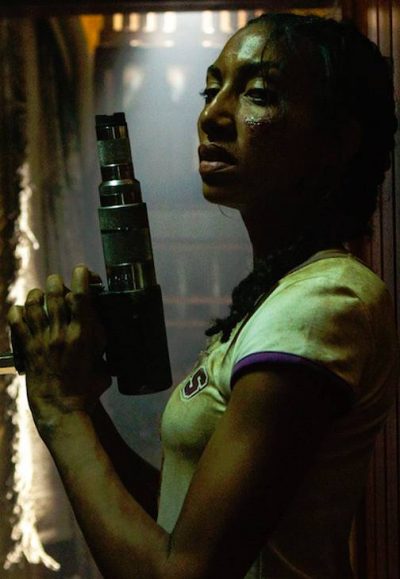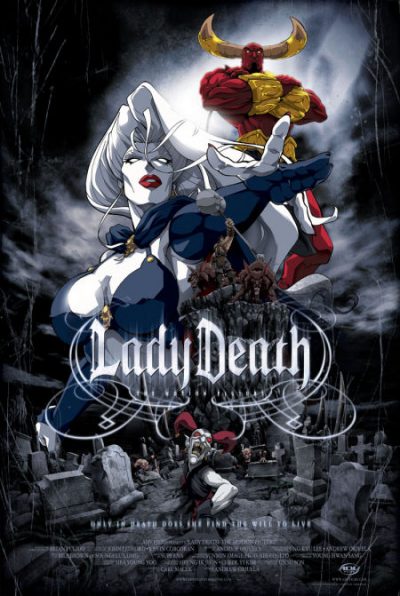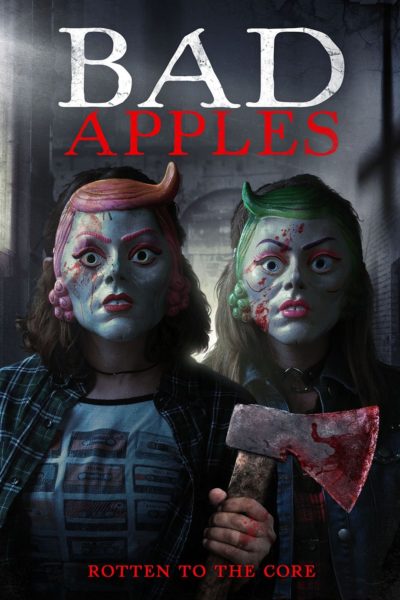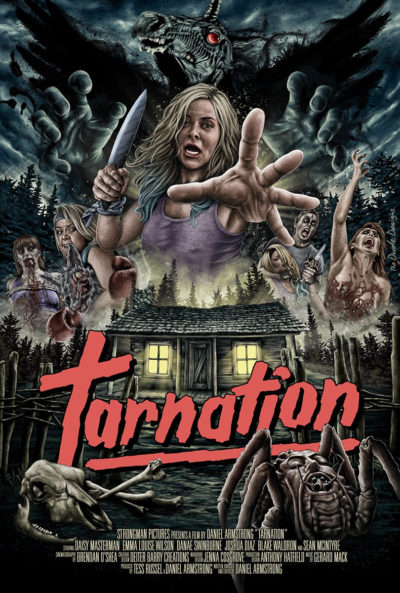★★★★
“Guess a new domain name is needed…”

 Lurking behind one of the most cringeworthy titles I’ve ever seen, and a trailer that’s not much better, is a very pleasant surprise. Well, at least if you’re a fan of the “splatstick” genre, mixing over-the-top gore and comedy: Peter Jackson’s Brain Dead is the pinnacle of that genre. I certainly am, and consequently found this a real hoot. Girls volleyball team, the Falcons, are on their way home after their latest victory, when they end up diverted into a small town, populated entirely by inbred rednecks (or the Gallic version thereof). After an encounter in the hotel, they find themselves getting a night-time visit, and are soon being hunted down by the village’s residents. However, the biggest psycho may not be among the locals…
Lurking behind one of the most cringeworthy titles I’ve ever seen, and a trailer that’s not much better, is a very pleasant surprise. Well, at least if you’re a fan of the “splatstick” genre, mixing over-the-top gore and comedy: Peter Jackson’s Brain Dead is the pinnacle of that genre. I certainly am, and consequently found this a real hoot. Girls volleyball team, the Falcons, are on their way home after their latest victory, when they end up diverted into a small town, populated entirely by inbred rednecks (or the Gallic version thereof). After an encounter in the hotel, they find themselves getting a night-time visit, and are soon being hunted down by the village’s residents. However, the biggest psycho may not be among the locals…
Afonso does a great job in depicting the heroines with broad strokes. You quickly establish the egotistical star player Morgane (Azem), up and coming star Jeanne (Daviot), nerdy M.A. (Balchere), etc. They’re all overseen by their distinctly non-athletic coach (Solaro), who treats them as if they were one big, dysfunctional family. Yet these internal tensions often threaten their literal survival. It was clear to me (if not many reviewers!) that Afonso is parodying the slasher genre: he takes it to such extremes, with the girls bickering over boyfriends even as their pursuers are mere feet away. That’s where this differs from the other “women’s sports team in wilderness peril” movie – yes, it’s a genre… well, there are two – Blood Games, which took itself seriously. He does an equally nice job with the villains. For example, rather than having hunting dogs, there’s one local who pretends to be a dog, playing the sound of hounds baying over a bullhorn.
It’s just one of the many times where this film subverts the audience’s expectations, not least in having heroines with their own set of flaws. Also included there is the country-and-western singer who hitches a ride on the team’s camper van, interrupting proceedings to offer sardonic commentary on proceedings. “The players on this team were all kind of hot”, he sings at the start, going on, “Another thing they have in common, is that they die before the end.” [Is he telling the truth? I won’t say…] Inevitably, of course, there’s a rather dumb scene where the girls use volleyballs to attack their enemies, and the climax doesn’t actually stick in the mind as well as many of the scenes which preceded it. The attack chihuahua, or the headless corpse that Just. Won’t. Die.
If you took this seriously, it would potentially be thoroughly offensive – though it’s entirely equal-opportunity in its approach there. Men, women, gay or straight: no-one here gets out alive. Just, for the love of all that is holy, skip the dubbed version on Netflix, and watch it subtitled. I caught a few seconds before lunging for the remote control, and my ears may still be bleeding.
Dir: Olivier Afonso
Star: Tiphaine Daviot, Manon Azem, Louise Blachère, Victor Artus Solaro





 My first viewing of this was on a day off from work, when I was down with some sinusy thing, and dosed up on DayQuil. So I chalked my losing interest and drifting off to the meds, and once I felt better, decided this deserved the chance of a re-view. However, the result was still the same: even as a bright-eyed and bushy-tailed viewer, I found attention lapsing. For this animated version of a mature comic, might as well be a He-Man and the Masters of the Universe episode. Which is a shame. I wanted to like it, since the creator of Lady Death, Brian Pulido, is something of a local comics legend here in my adopted home state of Arizona. This should have been better.
My first viewing of this was on a day off from work, when I was down with some sinusy thing, and dosed up on DayQuil. So I chalked my losing interest and drifting off to the meds, and once I felt better, decided this deserved the chance of a re-view. However, the result was still the same: even as a bright-eyed and bushy-tailed viewer, I found attention lapsing. For this animated version of a mature comic, might as well be a He-Man and the Masters of the Universe episode. Which is a shame. I wanted to like it, since the creator of Lady Death, Brian Pulido, is something of a local comics legend here in my adopted home state of Arizona. This should have been better. This is about the third Lovecraftian film I’ve seen with a heroine in the past year or so, after
This is about the third Lovecraftian film I’ve seen with a heroine in the past year or so, after  Wannabe actress Rosa (de Armas) is on the way home from her job as a hotel maid when she gets a message telling her she has a call-back the next day for a final audition. With her washing machine broken, she pops into the local 24-hour laundromat to get her costume all spick and span. It and the surrounding streets are completely deserted, and it’s not long before she’s being menaced by the kind of hulking, silent figure only found in horror movies like this. She’s delighted when hunky co-launderer Gabriel (Cadavid) shows up to rescue her, despite his strange tastes in music. But is he really as nice as he seems?
Wannabe actress Rosa (de Armas) is on the way home from her job as a hotel maid when she gets a message telling her she has a call-back the next day for a final audition. With her washing machine broken, she pops into the local 24-hour laundromat to get her costume all spick and span. It and the surrounding streets are completely deserted, and it’s not long before she’s being menaced by the kind of hulking, silent figure only found in horror movies like this. She’s delighted when hunky co-launderer Gabriel (Cadavid) shows up to rescue her, despite his strange tastes in music. But is he really as nice as he seems? I usually try to be tolerant when it comes to low-budget cinema and the resulting flaws. There are some things which you just cannot expect when a film is financed on the maker’s credit-card, and I’m willing to overlook rough edges if a movie can hold my interest in other ways. However, there are times when the end product is almost irredeemably bad, with few, if any, merits. This would be one such case. Your script is the main area which should be an area of equal opportunity, regardless of budget. Here, if anything, the flaws at the technical level are magnified by the failings on the page.
I usually try to be tolerant when it comes to low-budget cinema and the resulting flaws. There are some things which you just cannot expect when a film is financed on the maker’s credit-card, and I’m willing to overlook rough edges if a movie can hold my interest in other ways. However, there are times when the end product is almost irredeemably bad, with few, if any, merits. This would be one such case. Your script is the main area which should be an area of equal opportunity, regardless of budget. Here, if anything, the flaws at the technical level are magnified by the failings on the page. Ineptly constructed on just about every level, this proves that stealing from better movies – most obviously, Halloween and The Strangers – is not a guaranteed recipe for success. Teacher Ella (Grant) is has just moved into a new home with her husband, Robert (Skipper), who works at the local hospital. Left alone in the house on Halloween night – that whirring sounds are my eyes rolling – Ella becomes the target for two young girls (Prichard + Collins) in masks, whose unfortunate pre-natal experience has apparently left them with severely psychotic tendencies. Or so we are left to presume, for the bulk of what follows.
Ineptly constructed on just about every level, this proves that stealing from better movies – most obviously, Halloween and The Strangers – is not a guaranteed recipe for success. Teacher Ella (Grant) is has just moved into a new home with her husband, Robert (Skipper), who works at the local hospital. Left alone in the house on Halloween night – that whirring sounds are my eyes rolling – Ella becomes the target for two young girls (Prichard + Collins) in masks, whose unfortunate pre-natal experience has apparently left them with severely psychotic tendencies. Or so we are left to presume, for the bulk of what follows. I could have sworn I’d seen this before, to the point where I almost skipped over it on Amazon Prime. But on checking, appears not. Did I watch it, and just not review it? Or does it only
I could have sworn I’d seen this before, to the point where I almost skipped over it on Amazon Prime. But on checking, appears not. Did I watch it, and just not review it? Or does it only  Following on after
Following on after  This has the potential to be truly bad, and you need to be willing to look past ropey production values, a possibly deliberately shaky grasp of period (unless “Daisy” really was a popular girls’ name in early medieval times…) and uncertainty as to whether or not this is intended to be a comedy. Yet, I have to admire its “everything including the kitchen sink” approach: throwing together elements from genres as disparate as Vikings, zombies, aliens, sword ‘n’ sorcery and female vengeance shows… well, ambition, at the very least.
This has the potential to be truly bad, and you need to be willing to look past ropey production values, a possibly deliberately shaky grasp of period (unless “Daisy” really was a popular girls’ name in early medieval times…) and uncertainty as to whether or not this is intended to be a comedy. Yet, I have to admire its “everything including the kitchen sink” approach: throwing together elements from genres as disparate as Vikings, zombies, aliens, sword ‘n’ sorcery and female vengeance shows… well, ambition, at the very least. This got off to a frankly rocky start, to the point that a few pages in, this felt like it might become a very rare DNF (Did Not Finish) book. It’s an incredibly clumsy and stilted opening, depicting the internal conversation between Sailor Ray and the demon who inhabits her. Literally, “Why am I reading this?” bad. Still, I persisted: and in the end, the story redeemed itself, though the final third was considerably weaker overall.
This got off to a frankly rocky start, to the point that a few pages in, this felt like it might become a very rare DNF (Did Not Finish) book. It’s an incredibly clumsy and stilted opening, depicting the internal conversation between Sailor Ray and the demon who inhabits her. Literally, “Why am I reading this?” bad. Still, I persisted: and in the end, the story redeemed itself, though the final third was considerably weaker overall.